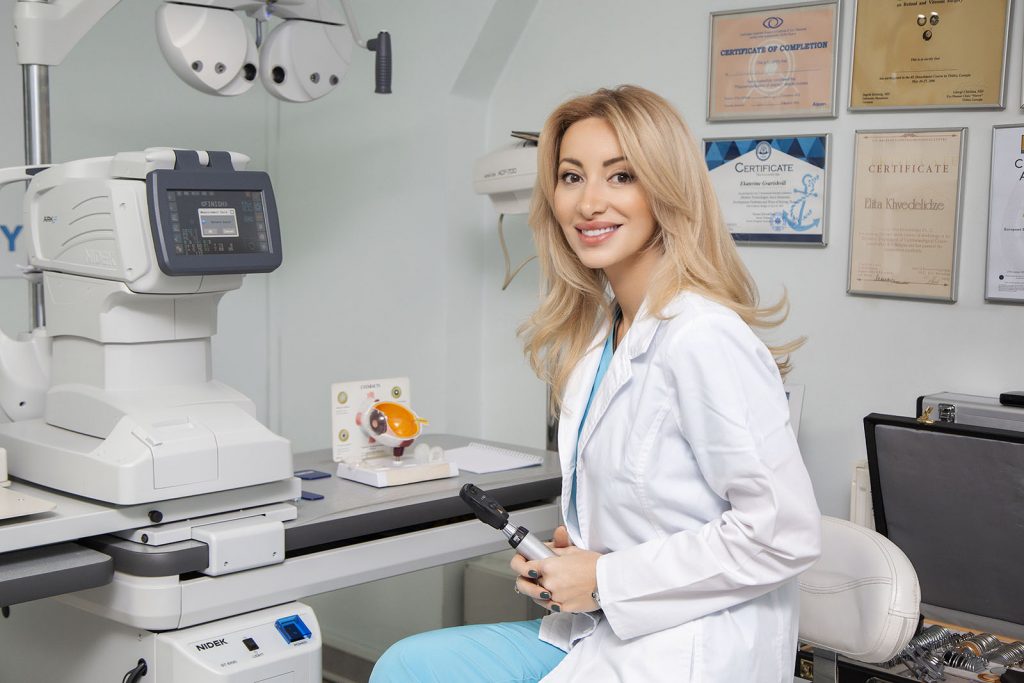
Ophthalmology examination and visit ophthalmologist in Batumi
The first eye examination is carriedout in the maternity ward on the first days of the baby’s life. If this does not happen, it is recommended to visit an ophthalmologist within a month after birth. (Children born prematurely have a special schedule for examinations).
During a standard eye examination – with biomicroscopy, an ophthalmologist checks the eyelids and the condition of the tear tubes (about 30% have congenital obstruction of the tear ducts, which may require special treatment), as well as checks the conjunctiva (thin transparent tissue) cornea and lens. The doctor also checks the inherent anomalies (strabismus, glaucoma, cataracts, etc.), which, in case of such, You needurgent treatment. It is also important to know that congenital cataractA is subject to surgical treatment (no later than 6 months after birth) . Examination also includes an examination of the condition of the bottom of the eye.
Ophthalmoscopy in Batumi
Ophthalmoscopy – the condition of the optic nerve and blood vessels is also checked. To determine eye refraction of newborns and children aged 2-3 years, skiascopy is used, an objective study method of clinical refraction based on observing the movement of shadows obtained in the area of vision.
Book an appointment with our ophthalmologist
In the presence or absence of pathology, the next consultation with an ophthalmologist is planned after 6-12 months. During this period, the child’s eye goes through the phase of active growth, it is possible to form: far-sightedness, astigmatism, congenital myopia, or anisomemetropia. Conducting an examination using “skiascopy” at this age is very important, since the quality of vision of the child in the future depends on its results. From the second month of the child’s birth, it is possible to determine whether he needs any correction to the eye, and from the age of six months it becomes possible to wear glasses as needed.
Prevent strabismus in children in Batumi
In addition to the above, the critical age is 2.5 – 3 years, when a binocular, “three-dimensional” (3D vision, the ability of the eyes to determine the position of objects in a three-dimensional space) vision is formed. This is the age of development of concomitant strabismus. In most cases, early detection of refractive change and appointment of adequate adjustments is the best way to prevent strabismus.
Important to consult an ophthalmologist once a year
It is important to consult an ophthalmologist once a year. At the age of 7 – 14 years, the risk of developing myopia is common, so a timely visit to an ophthalmologist will help reduce the rate of visual impairment. At the age of 13 – 20 years, hormonal changes and an increase in eye strain can manifest itself in the form of headaches and eye pain, astigmatism may develop – An ophthalmologist can prescribe a full precision treatment in this situation.
After this comes a period of 35-40 years, when all organs of the body work with maximum efficiency. After the processes of “dehydration” of tissues begin, which also affects the eyes – there are problems with close vision, the eyes suffer from a lack of moisture, intraocular pressure may increase.
After 55-60 years, “age-related” diseases may begin: retinal dystrophy, cataracts, glaucoma. And only timely detection and early prevention can ensure vision is maintained until old age.
Standard examination of an ophthalmologist includes:
Biomicroscopy in Batumi
Biomicroscopy is a method of visual examination of the tissues of the eye and its light turning areas, which is performed through a fissure lumen of the eye and its light turning areas, which is performed through a fissure lumen (examination of the anterior section of the eye). At the same time, the doctor can determine the presence of chronic inflammation, the risk of developing glaucoma or cataracts.
Phonoscopy in Batumi
Phonoscopy – a foundation check can be carried out using a microscope and a special lens – you can see the periphery of the retina. A monocular or binocular ophthalmoscope can also be used – N is pre-used to visualize the peripheral parts of the retina. It is also possible to use a special device – a fundcoscope – where the digital image of the foundation is stored in the computer’s memory and can be accessed at any time. During the examination, a conclusion is made on the general condition of the vascular system of the body and the degree of compensation for various diseases.
Kerato refractometry in Batumi
Kerato refractometry – measurement of the curvature of the cornea and examination of the eye using a special device (myopia, foresight, astigmatism are detected at this stage). Based on this data, you can mixglasses or contact lenses.
Retinoscopy in Batumi
Retinoscopy – a variant of refractometry, performed using retinoscopes and neutralizing lenses. This is the most accurate method of determining pathologies in children.
Tonometry in Adjara
Tonometry – tonometry is a procedure by which the pressure in the eye is measured. This study is important to diagnose such a serious pathology as glaucoma.
The test of visual acuity in Batumi
The test of visual acuity – according to special tables, can be determined: degree of myopia, foresight or astigmatism. And in children, in this way, it is possible to determine the primary stage of development of amblyopia – the “lazy eye” and timely treatment.
Perimeter visual fields examination in Batumi
Perimeter – the study of visual fields on a special device. It lasts from 5 to 25 minutes and provides very important information about the functional state of the retina, optic nerve, visual vision and functional state.
The best ophthalmologists of the “SAGITTARIUS” clinic in Batumi, Georgia, treat various eye diseases.
Write to us in the chat on this page for a consultation.
